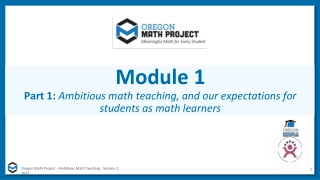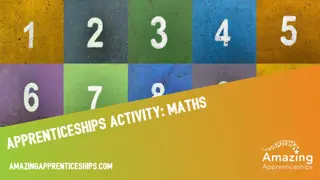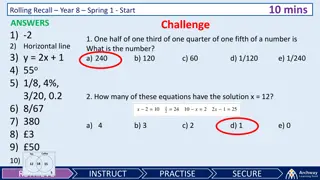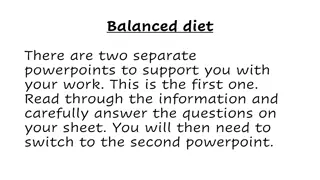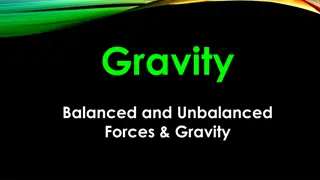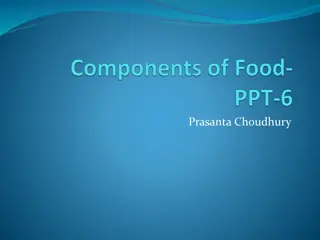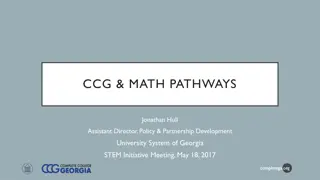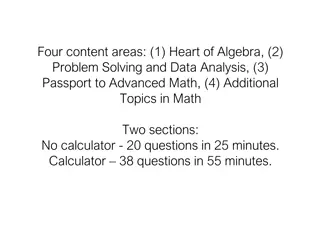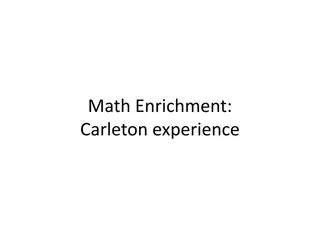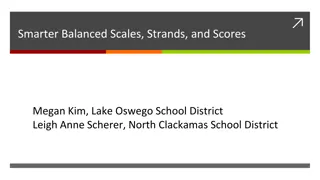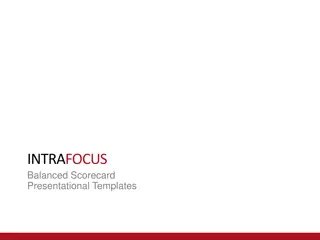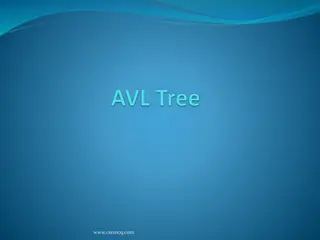Balanced Math Program Overview
This presentation introduces the Balanced Math Program brought to you by Math Coaches Lisa Shogren and Jenn Vomocil. The session covers the goals of the program, including understanding the five steps involved: Math Review, Mental Math, Problem Solving, Conceptual Understanding, Mastery of Math Facts, and Common Formative Assessment. It delves into each step with models and practices to enhance computational skills and develop a strong foundation in mathematics. Participants are encouraged to engage by placing questions in the Parking Lot for discussion throughout the session.
Download Presentation

Please find below an Image/Link to download the presentation.
The content on the website is provided AS IS for your information and personal use only. It may not be sold, licensed, or shared on other websites without obtaining consent from the author.If you encounter any issues during the download, it is possible that the publisher has removed the file from their server.
You are allowed to download the files provided on this website for personal or commercial use, subject to the condition that they are used lawfully. All files are the property of their respective owners.
The content on the website is provided AS IS for your information and personal use only. It may not be sold, licensed, or shared on other websites without obtaining consent from the author.
E N D
Presentation Transcript
BALANCED MATH Brought to you by your Math Coaches: Lisa Shogren (primary) or Jenn Vomocil (intermediate)
GOALS FOR THIS SESSION Understand the Balanced Math Program Understand Step 1 - Math Review slice. Model and Practice Math Review Understand Step 1 - Mental Math slice. Model and Practice Mental Math Please place questions in the Parking Lot and they will be answered throughout the session.
FIVE STEPS TO A BALANCED MATH PROGRAM 1. Math Review and Mental Math (Computational Skills) 2. Problem Solving 3. Conceptual Understanding 4. Mastery of Math Facts 5. Common Formative Assessment
FIVE STEPS TO A BALANCED MATH PROGRAM Step 1 - Math Review and Mental Math (Computational Skills) Step 2 - Problem Solving Step 3 - Conceptual Understanding Step 4 - Mastery of Math Facts Step 5 - Common Formative Assessment
FIVE STEPS TO A BALANCED MATH PROGRAM Step 1 - Math Review and Mental Math (Computational Skills) Step 2 - Problem Solving Step 3 Conceptual Understanding Step 4 - Mastery of Math Facts Step 5 - Common Formative Assessment
FIVE STEPS TO A BALANCED MATH PROGRAM Step 1 - Math Review and Mental Math (Computational Skills) Step 2 - Problem Solving Step 3 - Conceptual Understanding Step 4 - Mastery of Math Facts Step 5 - Common Formative Assessment
FIVE STEPS TO A BALANCED MATH PROGRAM Step 1 - Math Review and Mental Math (Computational Skills) Step 2 - Problem Solving Step 3 - Conceptual Understanding Step 4 - Mastery of Math Facts Step 5 - Common Formative Assessment
GOALS FOR THIS SESSION Understand the Balanced Math Program Understand Step 1 - Math Review slice. Model and Practice Math Review Understand Step 1 - Mental Math slice. Model and Practice Mental Math Please place questions in the Parking Lot and they will be answered throughout the session.
MATH REVIEW (20-25%) 3 to 5 problems Deliberately selected concepts (themes) Consistent for 1 week minimum Half of the time is student work time Half of the time is process time Weekly Assessments (6-10 problems) Students reflect on their learning after each assessment Not a time for new content instruction
POSSIBLE MATH REVIEW THEMES Intermediate Grades Place Value Addition Subtraction Multiplication Division Fractions Decimals Measurement Geometry
TEACHERS ROLE DURING MATH REVIEW Giving encouragement Math Review is a time for practice. We are all trying to get better at this, so let s help each other as much as possible. Time for practice Creating a safe environment to reflect and learn for their mistakes Learning is a process that begins with not knowing. As we practice and help each other, we come to understand. During work times teacher circulates to help students individually
THE IMPORTANCE OF PROCESSING THE MATH REVIEW Possible Math Review Processes Teacher Directed Student Volunteer Pass the pen Speedy system Row or Group expert Row or Group representative Many more Emphasize reasonableness of answer
WEEKLY REVIEW ASSESSMENT 2 questions for each theme Formative assessment Drives questions for following week 80% to be proficient Gives teacher diagnostic information on a regular basis Immediate feedback to students Students reflect on their current level of understanding Communication home
MODELING MATH REVIEW Take 7 minutes to complete the problems on your math review worksheet.
PLACE VALUE Write the number in words Write the number in Expanded Notation Write the number in Place Value Notation Say the number with place value names Ask students the value of each numeral (digit) Ask students what number is 10 more; 100 more; 100 less and so on
ADDITION / SUBTRACTION Find the sum or difference Ask students for a good estimate to justify the reasonableness of their answer Ask students how they might solve the problem mentally Ask students to share their strategies for solving the problem Model the sum or difference on a number line or with a diagram For subtraction, have students try the counting up strategy
MULTIPLICATION / DIVISION Show multiplication with an array, equal groups, jumps on the number line, and/or repeated addition Ask students for a good estimate to justify the reasonableness of their answer Ask students how they might solve the problem mentally Ask students to share their strategies for solving the problem Ask students what multiplication or division mean (groups of or broken into equal groups) Explain the meaning of the remainder
FRACTIONS Ask what the fraction means Ask students what the denominator indicates Ask students what the numerator indicates Have students draw a picture of the fraction Ask which benchmark fraction is closest to the fraction (or mixed number given)
DECIMALS Ask students to use whole numbers to get a reasonable estimate Demonstrate that a reasonable estimate can be used to locate the decimal in the answer, rather than teaching students the algorithm.
MEASUREMENT Ask students what the prefixes in metric mean ( centi- means 100, kilo- means 1,000) Remind students that the metric system is based on powers of 10 Ask students how many of one unit there are in another (inches in a foot; inches in a yard; feet in 1 yard, 2 yards, 3 yards, etc) Ask for examples of items that are close to the measurement they were converting
GEOMETRY Ask students for the definition of perimeter and its appropriate unit of measure (the linear measure around the outside of a geometric figure expressed in single units) Ask students for the definition of area and its appropriate unit of measure (a measure of covering that is expressed in square units) Ask students to make a drawing to prove the area answer
GOALS FOR THIS SESSION Understand the Balanced Math Program Understand Step 1 - Math Review slice. Model and Practice Math Review Understand Step 1 - Mental Math slice. Model and Practice Mental Math Please place questions in the Parking Lot and they will be answered throughout the session.
MENTAL MATH (5-7%) Build number sense Builds foundational skills to develop fluency Effective computation skills Daily mental practice Themed minimum of 1 week per theme Teacher created or student created Investigations 10-minute math or classroom routines may work as well
POSSIBLE MENTAL MATH THEMES 3RD 5THGRADE Counting by a given number Multiples of a given number Basic facts Measuring Inverse Operations Fractions Geometry Vocabulary Multiplication; powers of 10 Measurement Conversions
STEPS FOR MENTAL MATH First time, record answer only in math journal. (no one shares their answer yet) Second time, If you got lost, we are going to do the same problem again. If you think you know the correct answer, calculate it again to make sure. At the end, choral response of answer. Third time, We are going to do it again. We will work on the problem step-by-step for you to analyze where you might have made an error. 1. 2. 3.
MODEL MENTAL MATH Pencils Down
GOALS FOR THIS SESSION Understand the Balanced Math Program Understand Step 1 - Math Review slice. Model and Practice Math Review Understand Step 1 - Mental Math slice. Model and Practice Mental Math Please place questions in the Parking Lot and they will be answered throughout the session.
BRAINSTORM Math Review Themes What holes do you think students will come to you with? What level of rigor can they be successful at? What is the next level of rigor you will move to after 80% are proficient? What level of rigor do students need to get to before you can change themes? Mental Math Themes Pick one number that you want to start the year with and write 4 mental math sequences for that same theme
THANK YOU! I know you would rather be getting your rooms ready, but this is IMPORTANT stuff! Monthly Grade Level Meetings start in October. are all at Timber Ridge at 4pm 3rd grade 3rd Tuesday of the Month (Nov. conflict goes to 4th Tuesday) 4th grade 1st Tuesday of the Month (Jan. conflict goes to 4th Tuesday) 5th grade 2nd Tuesday of the Month

 undefined
undefined



